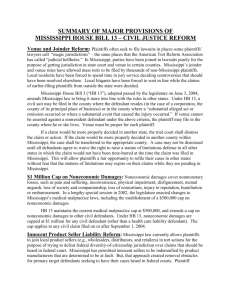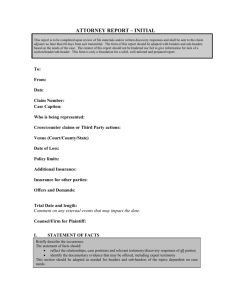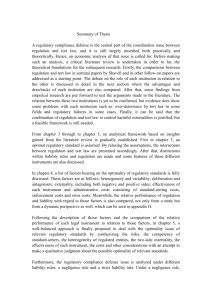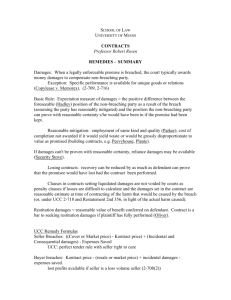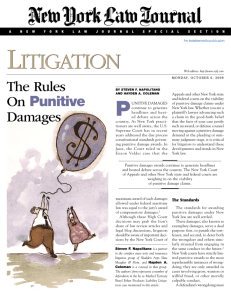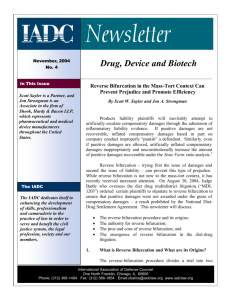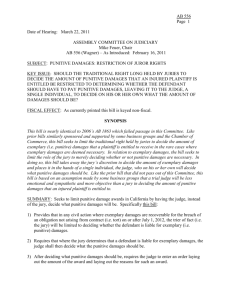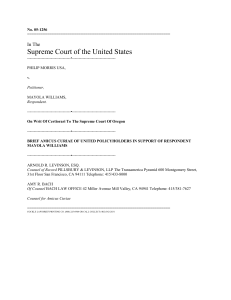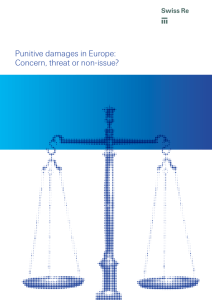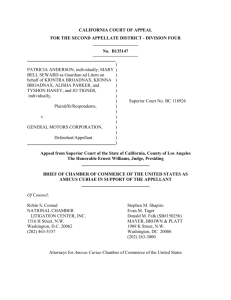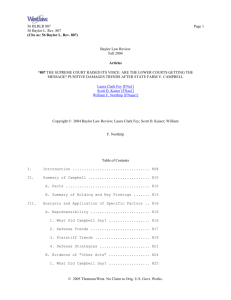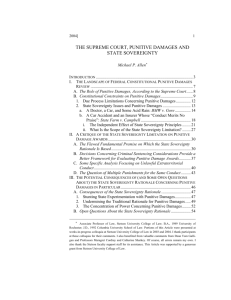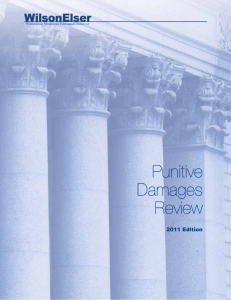“Reverse Bifurcation” Approach to Punitive Damages Trials in West
advertisement
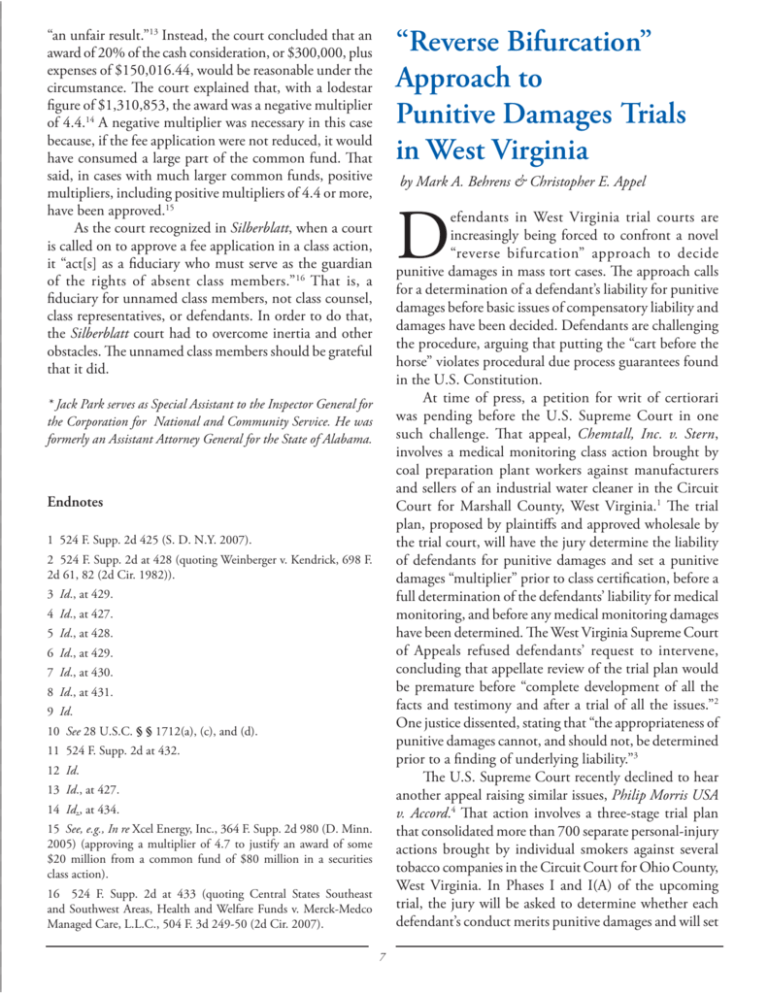
“an unfair result.”13 Instead, the court concluded that an award of 20% of the cash consideration, or $300,000, plus expenses of $150,016.44, would be reasonable under the circumstance. The court explained that, with a lodestar figure of $1,310,853, the award was a negative multiplier of 4.4.14 A negative multiplier was necessary in this case because, if the fee application were not reduced, it would have consumed a large part of the common fund. That said, in cases with much larger common funds, positive multipliers, including positive multipliers of 4.4 or more, have been approved.15 As the court recognized in Silberblatt, when a court is called on to approve a fee application in a class action, it “act[s] as a fiduciary who must serve as the guardian of the rights of absent class members.”16 That is, a fiduciary for unnamed class members, not class counsel, class representatives, or defendants. In order to do that, the Silberblatt court had to overcome inertia and other obstacles. The unnamed class members should be grateful that it did. “Reverse Bifurcation” Approach to Punitive Damages Trials in West Virginia by Mark A. Behrens & Christopher E. Appel D efendants in West Virginia trial courts are increasingly being forced to confront a novel “reverse bifurcation” approach to decide punitive damages in mass tort cases. The approach calls for a determination of a defendant’s liability for punitive damages before basic issues of compensatory liability and damages have been decided. Defendants are challenging the procedure, arguing that putting the “cart before the horse” violates procedural due process guarantees found in the U.S. Constitution. At time of press, a petition for writ of certiorari was pending before the U.S. Supreme Court in one such challenge. That appeal, Chemtall, Inc. v. Stern, involves a medical monitoring class action brought by coal preparation plant workers against manufacturers and sellers of an industrial water cleaner in the Circuit Court for Marshall County, West Virginia.1 The trial plan, proposed by plaintiffs and approved wholesale by the trial court, will have the jury determine the liability of defendants for punitive damages and set a punitive damages “multiplier” prior to class certification, before a full determination of the defendants’ liability for medical monitoring, and before any medical monitoring damages have been determined. The West Virginia Supreme Court of Appeals refused defendants’ request to intervene, concluding that appellate review of the trial plan would be premature before “complete development of all the facts and testimony and after a trial of all the issues.”2 One justice dissented, stating that “the appropriateness of punitive damages cannot, and should not, be determined prior to a finding of underlying liability.”3 The U.S. Supreme Court recently declined to hear another appeal raising similar issues, Philip Morris USA v. Accord.4 That action involves a three-stage trial plan that consolidated more than 700 separate personal-injury actions brought by individual smokers against several tobacco companies in the Circuit Court for Ohio County, West Virginia. In Phases I and I(A) of the upcoming trial, the jury will be asked to determine whether each defendant’s conduct merits punitive damages and will set * Jack Park serves as Special Assistant to the Inspector General for the Corporation for National and Community Service. He was formerly an Assistant Attorney General for the State of Alabama. Endnotes 1 524 F. Supp. 2d 425 (S. D. N.Y. 2007). 2 524 F. Supp. 2d at 428 (quoting Weinberger v. Kendrick, 698 F. 2d 61, 82 (2d Cir. 1982)). 3 Id., at 429. 4 Id., at 427. 5 Id., at 428. 6 Id., at 429. 7 Id., at 430. 8 Id., at 431. 9 Id. 10 See 28 U.S.C. § § 1712(a), (c), and (d). 11 524 F. Supp. 2d at 432. 12 Id. 13 Id., at 427. 14 Id., at 434. 15 See, e.g., In re Xcel Energy, Inc., 364 F. Supp. 2d 980 (D. Minn. 2005) (approving a multiplier of 4.7 to justify an award of some $20 million from a common fund of $80 million in a securities class action). 16 524 F. Supp. 2d at 433 (quoting Central States Southeast and Southwest Areas, Health and Welfare Funds v. Merck-Medco Managed Care, L.L.C., 504 F. 3d 249-50 (2d Cir. 2007). 7 Eleventh Circuit a punitive damages “multiplier” for each defendant. The same jury will decide certain elements of compensatory liability based entirely on aggregate proof. In Phase II proceedings, different fact-finders will determine whether each plaintiff has established the remaining elements of his or her liability claims and is entitled to compensatory damages. The Phase I multiplier will then be used to fix the particular dollar amount of punitive damages owed by each defendant to each individual plaintiff. The West Virginia Supreme Court of Appeals refused defendants’ request for a writ of prohibition to stay the proceedings.5 Defendants challenging West Virginia’s “reverse bifurcation” approach argue that the procedure is foreclosed by the U.S. Supreme Court’s recent decisions in State Farm Mutual Automobile Insurance Co. v. Campbell6 and Philip Morris USA v. Williams.7 Those decisions emphasize that punishment must be focused on the defendant’s conduct toward the plaintiff, may be imposed only after a defendant has had a full opportunity to defend against the charge, and should only be imposed when the plaintiff’s proven compensatory damages are insufficient to serve the state’s objectives of deterrence and punishment. The West Virginia approach also conflicts with decisions from other courts.8 Critics argue that the West Virginia approach appears intended to wield a heavy club to pressure defendants to settle mass tort claims. Defendants may find it virtually impossible to receive a fair trial once the jury considers issues relevant to punitive damages. They may be branded as “bad actors” before the jury even considers whether they are legally responsible for any specific plaintiff’s harm. Typically in a bifurcated trial, juries determine punitive damages issues only after compensatory liability and damages have been determined. This procedure prevents evidence that is highly prejudicial and relevant only to the issue of punishment from being heard by jurors and improperly considered when they are determining basic liability. Such evidence may include inflammatory documents or the net worth of the defendant. Juries may be instructed to ignore such evidence in determining basic liability, but it is often difficult, as a practical matter, for jurors to do so. By deferring consideration of evidence relevant only to punitive damages, the standard bifurcated trial approach is intended to limit the potential for bias.9 The West Virginia approach seems intended to do the opposite—it maximizes the likelihood of bias and prejudice. West Virginia courts have been the focus of Concluded on page 9 widespread criticism for their handling of class actions and other mass tort cases. The state ranked at the bottom of a 2007 State Liability Systems Ranking Study conducted for the U.S. Chamber Institute for Legal Reform.10 The growing use of “reverse bifurcation” is likely to reinforce the perception that West Virginia courts mete out justice in an unfair manner, particularly when the defendant is a large out-of-state corporation. * Mark Behrens is a partner and Christopher Appel is an attorney in Shook, Hardy & Bacon L.L.P.’s Washington, D.C.-based Public Policy Group. Endnotes 1 No. 07-1033 (U.S., petition filed Feb. 8, 2008). 2 See State ex rel. Chemtall, Inc. v. Madden, 655 S.W.2d 161, 167 (W.Va. 2007). 3 Id. at 169 (Benjamin, J., concurring in part and dissenting in part). 4 No. 07-806, (U.S., petition filed Dec. 17, 2007), cert. denied, 2008 WL 482117 (U.S. Feb. 25, 2008) 5 See State ex rel. Philip Morris USA v. Recht, No. 072903 (W. Va. Nov. 7, 2007) (unreported). An earlier decision of the West Virginia Supreme Court of Appeals addressed similar issues. See In re Tobacco Litig., 624 S.E.2d 738 (W. Va. 2005). 6 583 U.S. 408 (2003). 7 127 S. Ct. 1057 (2007). 8 See In re Simon II Litig., 407 F.3d 125, 138 (2d Cir. 2005); Allison v. Citgo Petroleum Corp., 151 F.3d 402, 417-19 (5th Cir. 1998); Engle v. Liggett Group, Inc., 945 So. 2d 1246 (Fla. 2006) (per curiam), cert. denied, 128 S. Ct. 96 (2007); Southwestern Refining Co., Inc. v. Bernal, 22 S.W.3d 425, 433 (Tex. 2000). 9 See Victor E. Schwartz et al., Reining in Punitive Damages “Run Wild”: Proposals for Reform by Courts and Legislatures, 65 Brook. L. Rev. 1003, 1018-19 (1999); Victor E. Schwartz & Christopher E. Appel, Putting the Cart Before the Horse: The Prejudicial Practice of a “Reverse Bifurcation” Approach to Punitive Damages, 2 Chas. L. Rev. -- (forthcoming). 10 The American Tort Reform Foundation has called the entire state a “judicial hellhole.” 8




